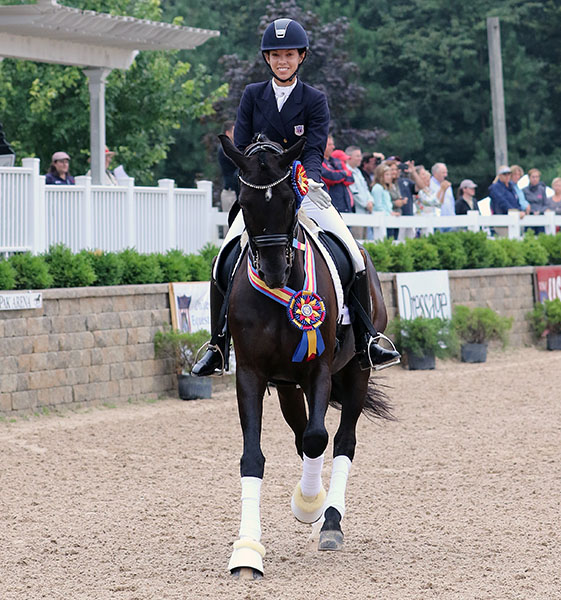Sagacious Released from Quarantine, New Tests Clear Horse of Deadly Glanders
8 years ago StraightArrow Comments Off on Sagacious Released from Quarantine, New Tests Clear Horse of Deadly Glanders

Aug. 24, 2017
By KENNETH J. BRADDICK
Sagacious HF was released from quarantine at Miami International Airport Thursday after new tests cleared the horse three weeks after a much-criticized American government procedure incorrectly diagnosed a deadly infection that could have required the horse to be put down.
Al Guden, owner for the 18 years’ life of of the Dutch gelding that won United States team gold at the 2007 Pan American Games and was returning early this month from a European competition tour, expressed relief at the resolution and pledged to join efforts to change U.S. Department of Agriculture testing protocols for the infectious virus glanders.
He credited Chase Hickok, the 27-year-old rider of Sagacious, and her coach and partner Endel Ots with leading the effort insure that Sagacious was thoroughly tested to leave no doubt about the results, and Lexington, Kentucky attorney Chapman Hopkins who had been involved with an Irish Thoroughbred that had undergone a similar procedure.
The USDA has used a complement fixation test (CFT) that is prescribed for international trade but is regarded by many veterinarians, especially those dealing with high performance horses for international dressage, jumping and eventing competition, as not accurate enough. The USDA is reported to have plans to replace it with a so-called “Western blot’ procedure as sought by Chapman Hopkins.
“I felt like I wasn’t in control of anything to do with the horse,” Al told dressage-news.com from his home in Wellington, Florida.
“Chapman did a wonderful job and the USDA altered the protocol to get an obviously healthy horse through the testing requirement. We will be working with a group of other people who have gone through this to permanently change the protocol–which is currently under review.
“Chase and Endel really led the charge on this effort. They got me involved when they found the attorney.
“Saving Sagacious goes to them.’
He said, however, “that we were all fully aware that glanders is a dangerous disease and is a bio terror agent so we were fully aware that if that first Western blot test came back positive we would have to put the horse down. The USDA was doing what was prescribed to protect the U.S. and did the right thing this time. Thanks to some folks who had the same problem before. But it can be streamlined and that’s our long term goal.”
USDA tests on Sagacious (Welt Hit II x Cocktail) on return from Europe initially produced two positive results for glanders, an infection that can be passed to humans as well as other animals.
Chapman Hopkins who had been involved in a similar case of an Irish racehorse last Christmas to help get U.S. government veterinarians to conduct the different tests that found the horse negative for glanders. That horse was released and just a week ago posted her first victory at Del Mar, California.
USDA agreed to put a hold on its protocol that the two positive results from the earlier tests would have required Sagacious to be returned to Amsterdam, the point of origin if the Netherlands allowed, or euthanized. Europe and the United States have been mostly glanders-free for seven decades, though an outbreak in Germany two years ago led to Australia imposing a six-month quarantine on horses being shipped Down Under.
Al Guden bought the horse originally named Sjors B at three months old and initially kept in the Netherlands. He brought the horse Sagacious, to America as a three-year-old, at first treating it as a “hobby” and not the “once in a lifetime” experience that resulted.
Lauren Sammis of South Orange, NewJersey began competing Sagacious HF–the HF representing Als Hyperion Farm–in 2006 and a year later was on the U.S. team for the Pan American Games in Rio de Janeiro. The event was fraught with emotion as Al’s wife had terminal breast cancer and was unable to go to Rio. Lauren dedicated the performances on Sagacious for team gold and individual silver to Judy Guden.
Lauren rode Sagacious in the national Grand Prix championships in 2009, 2010, 2011 and 2012.
Caroline Roffman, named the International Equestrian Federation (FEI) Rising Star in 2010, took over the ride and competed at Under-25 in the world’s premier horse show, at Aachen, Germany in 2013.
She and Sagacious, the first American combination to compete in Aachen’s Under-25 division, placed second.
After the European tour, Caroline dropped plans to qualify for the Brentina Cup Under-25 American championships figuring the horse had done enough at the time.
However, Chase Hickok was looking for an experienced Grand Prix mount that she could compete in the Under-25 division and leased the horse at the end of 2014. The horse and rider became a partnership, racking up 10 straight wins in Under-25 CDIs at the Global Dressage Festival in Wellington in 2015 then won the national Under-25 Brentina Cup title. The pair went to Europe for the summer. They moved up to Big Tour in 2016.
Chase rode on the American teams at the Nations Cups in Falsterbo, Sweden and Hickstead, England in July, becoming the highest placed American combination at both events and moving to No. 62 on the world rankings.
Glanders is caused by infection, usually from consuming contaminated feed or water. Signs of glanders include formation of lesions in the lungs and ulceration of mucous membranes in the upper respiratory tract. The acute form results in coughing, fever and the release of an infectious nasal discharge, followed by septicaemia and death within days. Endemic in Africa, Asia, the Middle East, and Central and South America, it has been eradicated from North America, Australia, and most of Europe through surveillance, destruction of affected animals and import restrictions.

